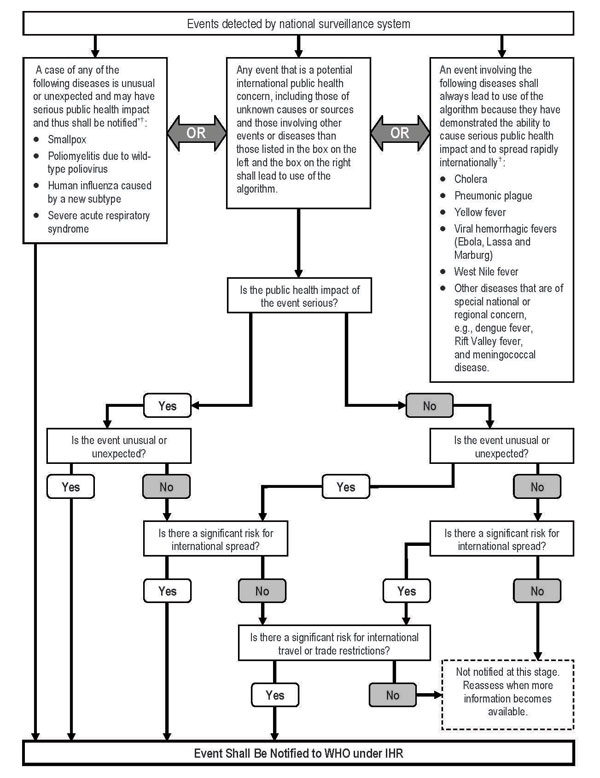Volume 14, Number 9—September 2008
Dispatch
Obligations to Report Outbreaks of Foodborne Disease under the International Health Regulations (2005)
Figure

Figure. Decision instrument for the assessment and notification of events that may constitute a public health emergency of international concern under International Health Regulations (IHR) (2005). WHO, World Health Organization. *As per WHO case definitions. †The disease list shall be used only for the purposes of these regulations; adapted from Annex II of IHR (2005), reported in (7).
References
- Ammon A, Tauxe RV. Investigation of multi-national foodborne outbreaks in Europe: some challenges remain. Epidemiol Infect. 2007;135:887–9. DOIPubMedGoogle Scholar
- Kaferstein FK, Motarjemi Y, Bettcher DW. Foodborne disease control: a transnational challenge. Emerg Infect Dis. 1997;3:503–10.PubMedGoogle Scholar
- Swaminathan B, Barrett TJ, Hunter SB, Tauxe RV. PulseNet: the molecular subtyping network for foodborne bacterial disease surveillance, United States. Emerg Infect Dis. 2001;7:382–9.PubMedGoogle Scholar
- Koopmans M, Vennema H, Heersma H, van Strien E, van Duynhoven Y, Brown D, Early identification of common-source foodborne virus outbreaks in Europe. Emerg Infect Dis. 2003;9:1136–42.PubMedGoogle Scholar
- Heymann DL. Control, elimination, eradication and re-emergence of infectious diseases: getting the message right. Bull World Health Organ. 2006;84:82. DOIPubMedGoogle Scholar
- International Health Regulations. the challenges ahead. Lancet. 2007;369:1763. DOIPubMedGoogle Scholar
- World Health Organization. The world health report 2007: a safer future: global public health security in the 21st century. Geneva: The Organization; 2007.
- World Health Organization. The identification, assessment and management of food safety events under the International Health Regulations (2005). INFOSAN information note no. 4/2007 – IHR (2005). Geneva: The Organization; 2007.
- Webby RJ, Carville KS, Kirk MD, Greening G, Ratcliff RM, Crerar SK, Internationally distributed frozen oyster meat causing multiple outbreaks of norovirus infection in Australia. Clin Infect Dis. 2007;44:1026–31. DOIPubMedGoogle Scholar
- Maric P, Ali SS, Heron LG, Rosenfeld D, Greenwood M. Methaemoglobinaemia following ingestion of a commonly available food additive. Med J Aust. 2008;188:156–8.PubMedGoogle Scholar
- Lewis HC, Kirk M, Ethelberg S, Stafford R, Olsen K, Nielsen EM, Outbreaks of shigellosis in Denmark and Australia associated with imported baby corn, August 2007—final summary. Euro Surveill. 2007;12:E071004 2.
- O’Grady K, Powling J, Tan A, Valcanis M, Lightfoot D, Gregory J, Salmonella Typhimurium DT104 - Australia, Europe. Promed Mail 2001.
- Unicomb LE, Simmons G, Merritt T, Gregory J, Nicol C, Jelfs P, Sesame seed products contaminated with Salmonella: three outbreaks associated with tahini. Epidemiol Infect. 2005;133:1065–72. DOIPubMedGoogle Scholar
- Kirk MD, Little CL, Lem M, Fyfe M, Genobile D, Tan A, An outbreak due to peanuts in their shell caused by Salmonella enterica serotypes Stanley and Newport – sharing molecular information to solve international outbreaks. Epidemiol Infect. 2004;132:571–7. DOIPubMedGoogle Scholar
- Forssman B, Mannes T, Musto J, Gottlieb T, Robertson G, Natoli JD, Vibrio cholerae O1 El Tor cluster in Sydney linked to imported whitebait. Med J Aust. 2007;187:345–7.PubMedGoogle Scholar
Page created: July 13, 2010
Page updated: July 13, 2010
Page reviewed: July 13, 2010
The conclusions, findings, and opinions expressed by authors contributing to this journal do not necessarily reflect the official position of the U.S. Department of Health and Human Services, the Public Health Service, the Centers for Disease Control and Prevention, or the authors' affiliated institutions. Use of trade names is for identification only and does not imply endorsement by any of the groups named above.